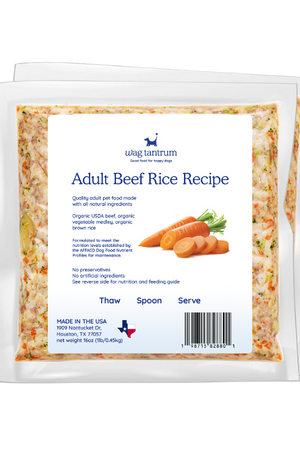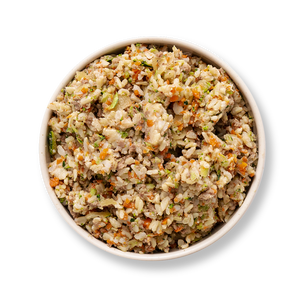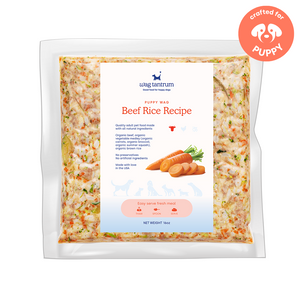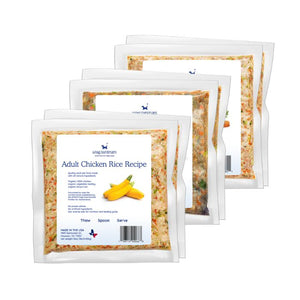What to Do for Dogs Allergic to Their Environment
What to Do for Dogs Allergic to Their Environment: How Fresh Dog Food Can Help
When your dog suffers from environmental allergies, it can feel like an endless battle. Whether it’s pollen, dust mites, mold, or pet dander, these allergens can cause discomfort and even serious health issues for your furry friend. But did you know that what you feed your dog could play a big role in managing those allergies? In this blog, we’ll explore how fresh dog food and pet fresh ingredients can help alleviate some of the symptoms of environmental allergies and improve your dog’s overall health.
Environmental Allergies in Dogs: A Growing Concern
Much like humans, dogs can develop sensitivities to substances in their environment. Common symptoms include itching, excessive licking, ear infections, watery eyes, and respiratory issues. While there are treatments like antihistamines and topical creams, the first step in managing your dog’s allergies should always be to reduce the allergens in their immediate environment. But that’s not all—diet plays a crucial role, too.
How Diet Can Impact Allergies
The right diet can help strengthen your dog's immune system and reduce inflammation, which can, in turn, alleviate some of the symptoms of allergies. A diet full of processed or low-quality ingredients may exacerbate inflammation, making allergy symptoms worse. On the other hand, feeding your dog fresh dog food made with high-quality, fresh ingredients can provide the nutrients needed to support a healthy immune system and reduce allergy flare-ups.
Why Choose Fresh Dog Food?
Fresh foods for dogs, such as those made with pet fresh ingredients, are packed with natural nutrients, vitamins, and minerals that help maintain a healthy immune response. Unlike traditional kibble, which often contains fillers and artificial additives, fresh dog food is minimally processed, making it easier for your dog to digest and absorb the nutrients. This can help reduce the inflammation that contributes to allergic reactions.
Additionally, fresh dog food typically has fewer ingredients, allowing you to better control what your dog is eating and avoid potential allergens. For example, if you know your dog is sensitive to grains or certain proteins, you can find dog food made specifically for those needs. Many brands even offer customizable options based on your dog’s individual sensitivities.
How to Find Dog Food That Helps with Allergies
When shopping for dog food to manage environmental allergies, look for these key features:
1. Limited Ingredients: A simple, limited-ingredient diet can help prevent allergic reactions. Look for food that has a single protein source, like chicken or turkey, and no fillers such as corn, wheat, or soy.
2. Novel Proteins: If your dog has a sensitivity to common protein sources like chicken or beef, try a food made with a novel protein, such as duck, lamb, or venison. Novel proteins can help reduce allergic reactions by providing a fresh protein source that your dog’s body is less likely to have been exposed to before.
3. Omega Fatty Acids: Fresh dog food rich in omega-3 and omega-6 fatty acids can help reduce inflammation and support skin health. These healthy fats can also improve the condition of your dog's coat and soothe itchy, dry skin that often accompanies allergies.
4. Grain-Free Options: Some dogs with environmental allergies may also have sensitivities to grains, which can cause digestive upset and skin irritation. Fresh, grain-free dog foods can be a good option for dogs with multiple sensitivities.
5. Probiotics: Healthy digestion is key to overall well-being, and probiotics can support your dog's gut health, which in turn supports their immune system. Many fresh dog food brands include natural probiotics to improve digestion and strengthen the immune response.
Fresh Dog Food: A Long-Term Solution
While fresh dog food won’t magically eliminate all allergy symptoms, it can provide long-term support by helping to reduce inflammation, boosting the immune system, and preventing flare-ups. Over time, your dog may begin to feel more comfortable, have fewer itching episodes, and experience healthier skin and coat conditions.
Other Tips for Managing Your Dog’s Environmental Allergies
In addition to switching to fresh dog food, here are some other tips to help manage your dog’s environmental allergies:
- Keep Your Home Clean: Regularly vacuum and dust your home to reduce allergens like pet dander, pollen, and mold. Consider investing in an air purifier for better air quality.
- Bathe Your Dog Regularly: Giving your dog regular baths with a gentle, hypoallergenic dog shampoo can help wash away pollen and other allergens that cling to their fur.
- Limit Outdoor Exposure: During high pollen seasons, try to limit your dog’s outdoor time, especially during peak hours in the morning or evening when pollen levels are highest.
- Consult Your Vet: If your dog’s allergy symptoms persist, it’s always a good idea to talk to your vet. They can help identify the root cause of the allergies and recommend appropriate treatments, such as antihistamines or allergy shots.
Conclusion
When your dog suffers from environmental allergies, choosing the right food can make a significant difference in their overall well-being. Fresh dog food made with high-quality, fresh ingredients can support your dog’s immune system, reduce inflammation, and improve skin health, making it an excellent choice for managing environmental allergies. By incorporating fresh foods for dogs into their diet, you’ll be taking an important step toward helping them feel more comfortable and healthier in their everyday environment.
If you’re ready to make the switch, take the time to find dog food that works best for your dog’s unique needs. Your furry friend will thank you!








